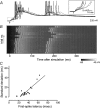Chronometric readout from a memory trace: gamma-frequency field stimulation recruits timed recurrent activity in the rat CA3 network
- PMID: 15375190
- PMCID: PMC1665348
- DOI: 10.1113/jphysiol.2004.066639
Chronometric readout from a memory trace: gamma-frequency field stimulation recruits timed recurrent activity in the rat CA3 network
Abstract
Synchronous population activity is prevalent in neurones of the central nervous system and experimentally captured as oscillatory electric fields, the frequency of which can represent the state of the neural circuit, e.g. theta (approximately 5 Hz) and gamma (approximately 40 Hz). Such field oscillations, however, are not merely a result of coherent neuronal activity. They may also play active roles in information processing in the brain. In this study, we observed that, in cultured hippocampal slices, CA3 pyramidal cells responded to single-pulse stimuli with monosynaptic and polysynaptic potentials and firing spikes which occurred after variable latencies. The variability of the spike latencies was greatly reduced in the presence of weak electric field oscillations, especially the oscillation in the gamma-band frequency range, that per se induced only small fluctuations in the subthreshold membrane potential, and this effect was inhibited by blockade of NMDA receptor activity. Furthermore, the latency of the firing spikes changed if the stimulus was applied at a different phase of the imposed gamma oscillations. These results may suggest that the background field oscillations serve as an extracellular time reference and assure accurate and stable decoding of a memory trace present in cortical feedback networks.
Figures




Similar articles
-
Properties of gamma-frequency oscillations initiated by propagating population bursts in retrohippocampal regions of rat brain slices.J Physiol. 1998 Jul 1;510 ( Pt 1)(Pt 1):191-208. doi: 10.1111/j.1469-7793.1998.191bz.x. J Physiol. 1998. PMID: 9625877 Free PMC article.
-
Spatiotemporal patterns of gamma frequency oscillations tetanically induced in the rat hippocampal slice.J Physiol. 1997 Aug 1;502 ( Pt 3)(Pt 3):591-607. doi: 10.1111/j.1469-7793.1997.591bj.x. J Physiol. 1997. PMID: 9279811 Free PMC article.
-
Mechanism of carbachol-induced 40 Hz gamma oscillations and the effects of NMDA activation on oscillatory dynamics in a model of the CA3 subfield of the hippocampus.J Theor Biol. 2022 Sep 7;548:111200. doi: 10.1016/j.jtbi.2022.111200. Epub 2022 Jun 15. J Theor Biol. 2022. PMID: 35716721
-
Caffeine-dependent stimulus-triggered oscillations in the CA3 region of hippocampal slices from rats chronically exposed to lead.Exp Neurol. 2004 Dec;190(2):525-34. doi: 10.1016/j.expneurol.2004.08.016. Exp Neurol. 2004. PMID: 15530891
-
Feedforward inhibition underlies the propagation of cholinergically induced gamma oscillations from hippocampal CA3 to CA1.J Neurosci. 2013 Jul 24;33(30):12337-51. doi: 10.1523/JNEUROSCI.3680-12.2013. J Neurosci. 2013. PMID: 23884940 Free PMC article.
Cited by
-
Sensitivity of coherent oscillations in rat hippocampus to AC electric fields.J Physiol. 2007 Sep 1;583(Pt 2):555-65. doi: 10.1113/jphysiol.2007.137711. Epub 2007 Jun 28. J Physiol. 2007. PMID: 17599962 Free PMC article.
-
Integrating information in the brain's EM field: the cemi field theory of consciousness.Neurosci Conscious. 2020 Sep 22;2020(1):niaa016. doi: 10.1093/nc/niaa016. eCollection 2020. Neurosci Conscious. 2020. PMID: 32995043 Free PMC article.
-
Effects of weak transcranial alternating current stimulation on brain activity-a review of known mechanisms from animal studies.Front Hum Neurosci. 2013 Oct 23;7:687. doi: 10.3389/fnhum.2013.00687. Front Hum Neurosci. 2013. PMID: 24167483 Free PMC article. Review.
-
An ephaptic transmission model of CA3 pyramidal cells: an investigation into electric field effects.Cogn Neurodyn. 2014 Jun;8(3):177-97. doi: 10.1007/s11571-013-9269-6. Epub 2013 Oct 5. Cogn Neurodyn. 2014. PMID: 24808928 Free PMC article.
-
Computing with electromagnetic fields rather than binary digits: a route towards artificial general intelligence and conscious AI.Front Syst Neurosci. 2025 Jun 25;19:1599406. doi: 10.3389/fnsys.2025.1599406. eCollection 2025. Front Syst Neurosci. 2025. PMID: 40636933 Free PMC article.
References
-
- Amaral DG, Witter MP. The 3-dimensional organization of the hippocampal-formation – a review of anatomical data. Neuroscience. 1989;31:571–591. - PubMed
-
- Amit DJ, Brunel N. Dynamics of a recurrent network of spiking neurons before and following learning. Network. 1997;8:373–404.
-
- Brody CD, Hopfield JJ. Simple networks for spike-timing-based computation, with application to olfactory processing. Neuron. 2003;37:843–852. - PubMed
MeSH terms
Substances
LinkOut - more resources
Full Text Sources
Miscellaneous

